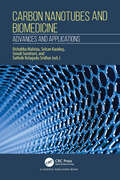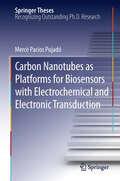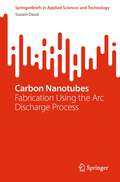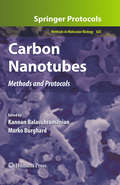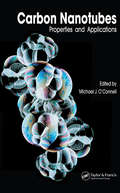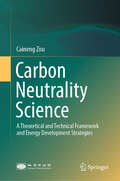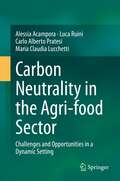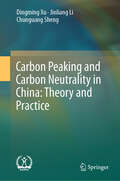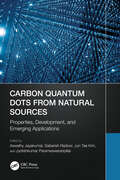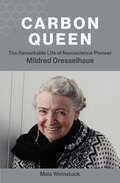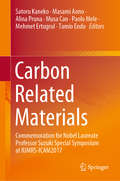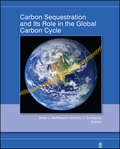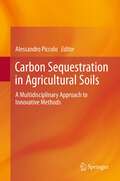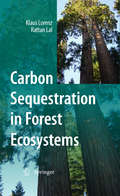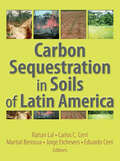- Table View
- List View
Carbon Nanotubes Mediated Bioactive Delivery
by N. K. Jain Neelesh Kumar MehraCarbon nanotubes (CNTs) have emerged as novel carbon-based nanomaterials with unique physicochemical properties for pharmaceutical and biomedical applications. This book provides the fundamental concept, basic physicochemical properties, functionalization, method of synthesis, applications, and regulatory considerations of CNTs. The primary objective of the editors and authors is to exhaustively cover the fundamentals of carbon nanomaterials, carbon nanotubes, functionalization and chemistries involved, drug delivery aspects, and applications along with their regulatory aspects.
Carbon Nanotubes and Biomedicine: Advances and Applications
by Sathvik Belagodu Sridhar Malviya Rishabha Karakuş Selcan Sundram SonaliThis book explores the advanced integration of nanotechnology and biomedicine, providing an in-depth analysis of the transformative impact of carbon nanotubes (CNTs) on healthcare. It provides a comprehensive coverage of the distinctive characteristics of CNTs, including their remarkable mechanical strength, electrical conductivity, and large surface area, which make them very suitable for numerous biomedical uses. The book provides an overview of the process of synthesizing and functionalizing CNTs. It then delves into the specific applications of CNTs in drug delivery systems to improve the effectiveness and targeting of therapeutic agents. Additionally, the book explores the use of CNTs in imaging and diagnostics, enhancing techniques such as MRI and fluorescence imaging. The book also discusses the involvement of CNTs in tissue engineering, namely in the fabrication of scaffolds that facilitate cell growth and tissue regeneration. It explores the application of CNTs in biosensors, where their high sensitivity enables early and accurate identification of diseases. Antibacterial characteristics of CNTs are reviewed in order to hinder infections in medical devices and implants. The potential of CNTs in gene therapy to enhance genetic treatments is also explored in the book. It addresses the concerns related to the toxicity, biocompatibility, and regulatory issues of CNTs. It carefully balances the promising potential of CNTs with the practical implications of their usage in the field of biomedicine. This book is indispensable for researchers, doctors, and individuals with an interest in the cutting-edge utilisation of nanotechnology in the field of medicine.
Carbon Nanotubes as Nanodelivery Systems: An Insight Through Molecular Dynamics Simulations (SpringerBriefs in Applied Sciences and Technology)
by Melvin Choon Lim Zhaowei ZhongThis book showcases the application of carbon nanotubes as nanodelivery systems for copper atoms, using molecular dynamics simulations as a means of investigation. The nanodelivery system of the carbon nanotube presents the possible usage of the carbon structure in many areas in the future. This book is comprehensive and informative, and serves as a guide for any reader who wishes to perform a molecular dynamics simulation of his own and to conduct an analytical study of a molecular system.
Carbon Nanotubes as Platforms for Biosensors with Electrochemical and Electronic Transduction (Springer Theses)
by Mercè Pacios PujadóThe thesis by Mercè Pacios exploits properties of carbon nanotubes to design novel nanodevices. The prominent electrochemical properties of carbon nanotubes are used to design diverse electrode configurations. In combination with the chemical properties and (bio)functionalization versatility, these materials prove to be very appropriate for the development of electrochemical biosensors. Furthermore, this work also evaluates the semiconductor character of carbon nanotubes (CNT) for sensor technology by using a field effect transistor configuration (FET). The CNT-FET device has been optimized for operating in liquid environments. These electrochemical and electronic CNT devices are highly promising for biomolecule sensing and for the monitoring of biological processes, which can in the future lead to applications for rapid and simple diagnostics in fields such as biotechnology, clinical and environmental research.
Carbon Nanotubes for Biomedical Applications (Carbon Nanostructures)
by Rüdiger Klingeler Robert B. SimThis book explores the potential of multi-functional carbon nanotubes for biomedical applications. It combines contributions from chemistry, physics, biology, engineering, and medicine. The complete overview of the state-of-the-art addresses different synthesis and biofunctionalisation routes and shows the structural and magnetic properties of nanotubes relevant to biomedical applications. Particular emphasis is put on the interaction of carbon nanotubes with biological environments, i.e. toxicity, biocompatibility, cellular uptake, intracellular distribution, interaction with the immune system and environmental impact. The insertion of NMR-active substances allows diagnostic usage as markers and sensors, e.g. for imaging and contactless local temperature sensing. The potential of nanotubes for therapeutic applications is highlighted by studies on chemotherapeutic drug filling and release, targeting and magnetic hyperthermia studies for anti-cancer treatment at the cellular level.
Carbon Nanotubes for Clean Water (Carbon Nanostructures Ser.)
by Rasel DasThis book presents carbon nanotubes as a potential material for the development of new waste water treatment technologies. Reviews on adsorption, catalysis, membrane, filtration and desinfection methods are provided. A special chapter presents the use of carbon nanotubes to sense and monitor water pollutants. The text underlies each technology and process as well as the current commercialization efforts. Research gaps are highlighted at the end with links to further reading material in the field.
Carbon Nanotubes: Fabrication Using the Arc Discharge Process (SpringerBriefs in Applied Sciences and Technology)
by Suzairi DaudThis book highlights a comprehensive understanding of the fabrication and growth of carbon nanostructures via the arc discharge process. Its content is designed to benefit academicians, students, researchers, scientists, and readers who are interested in gaining knowledge in this area. The book presents findings on the arc discharge process and provide detailed information on the optimal state and energy of carbon ions in arc discharge plasma, observed under different pressures and ambient environments. The contents presented here can be applied to enhance the performance of various applications. This book provides a valuable resource for those looking to gain a deeper understanding of the arc discharge process and the growth of carbon nanostructures, with practical applications in industries such as electronics, semiconductors, and energy storage.
Carbon Nanotubes: Methods and Protocols (Methods in Molecular Biology #625)
by Kannan Balasubramanian Marko BurghardDue to their rare combination of high chemical stability, exceptional optical and electrical properties, high surface-to-volume ratio, and high aspect ratio, carbon nanotubes (CNTs) have made an enormous impact on materials science, molecular biology, biomedicine, and bioanalytical chemistry. Carbon Nanotubes: Methods and Protocols provides reliable, consistent protocols on the application of CNTs in molecular biology-related fields. These are of vital importance, as the commercially available CNTs differ in purity, agglomeration state, as well as length and diameter distribution, all of which have a profound influence on the dispersability and surface properties of the tubes. The volume contains detailed sections on functionalization, toxicity, trafficking, scaffolds, and biosensors, provided by expert researchers from various fields. Written in the highly successful Methods in Molecular BiologyTM series format, chapters include introductions to their respective topics, lists of the necessary materials and reagents, step-by-step, readily reproducible laboratory protocols, and notes on troubleshooting and avoiding known pitfalls. Authoritative and cutting-edge, Carbon Nanotubes: Methods and Protocols serves to contribute to the achievement of common standards and helps researchers to avoid discrepancies in future biology-related CNT studies.
Carbon Nanotubes: Properties and Applications
by Michael J. O’ConnellSince their discovery more than a decade ago, carbon nanotubes (CNTs) have held scientists and engineers in captive fascination, seated on the verge of enormous breakthroughs in areas such as medicine, electronics, and materials science, to name but a few. Taking a broad look at CNTs and the tools used to study them, Carbon Nanotubes: Properties and Applications comprises the efforts of leading nanotube researchers led by Michael O’Connell, protégé of the late father of nanotechnology, Richard Smalley. Each chapter is a self-contained treatise on various aspects of CNT synthesis, characterization, modification, and applications. The book opens with a general introduction to the basic characteristics and the history of CNTs, followed by discussions on synthesis methods and the growth of “peapod” structures. Coverage then moves to electronic properties and band structures of single-wall nanotubes (SWNTs), magnetic properties, Raman spectroscopy of electronic and chemical behavior, and electromechanical properties and applications in NEMS (nanoelectromechanical systems). Turning to applications, the final sections of the book explore mechanical properties of SWNTs spun into fibers, sidewall functionalization in composites, and using SWNTs as tips for scanning probe microscopes. Taking a fresh look at this burgeoning field, Carbon Nanotubes: Properties and Applications points the way toward making CNTs commercially viable.
Carbon Nanotubes: Science and Applications
by M. MeyyappanCarbon nanotubes, with their extraordinary mechanical and unique electronic properties, have garnered much attention in the past five years. With a broad range of potential applications including nanoelectronics, composites, chemical sensors, biosensors, microscopy, nanoelectromechanical systems, and many more, the scientific community is more moti
Carbon Nanowalls: Synthesis and Emerging Applications
by Masaru Hori Mineo HiramatsuRepresenting the first text to cover this exciting new area of research, this book will describe synthesis techniques of CNWs, their characterization and various expected applications using CNWs. Carbon-nanowalls (CNWs) can be described as two-dimensional graphite nanostructures with edges comprised of stacks of plane graphene sheets standing almost vertically on the substrate. These sheets form a wall structure with a high aspect ratio. The thickness of CNWs ranges from a few nm to a few tens of nm. The large surface area and sharp edges of CNWs may prove useful for a number of applications such as electrochemical devices, field electron emitters, storage materials for hydrogen gas, catalyst support. In particular, vertically standing CNWs with a high surface-to-volume ratio, serve as an ideal material for catalyst support for fuel cells and in gas storage materials.
Carbon Neutrality Science: A Theoretical and Technical Framework and Energy Development Strategies
by Caineng ZouThis book focuses on the connotation and extension of carbon neutrality. It presents a full collection of various topics in carbon neutrality, including carbon production, reduction, utilization, storage, capture, markets, and society, etc. It concludes that carbon neutrality is the pathway to global green and low-carbon sustainable development and the foundation for building harmonious ecological civilization. This book is a valuable reference for researchers, practitioners, and policy-makers in the field of earth and environmental sciences.
Carbon Neutrality in the Agri-food Sector: Challenges and Opportunities in a Dynamic Setting
by Alessia Acampora Luca Ruini Carlo Alberto Pratesi Maria Claudia LucchettiThis book deals with the in-depth study of sustainability issues in the agri-food sector. In particular, a critical analysis of the current situation was developed and the future prospects of the sector on the issue of managing the environmental variable and the impacts relating to food production and consumption have been analyzed. Furthermore, the state of implementation and best practices relating to the carbon neutrality model in the agri-food sector were analyzed and models for the development of a new food production system were proposed with particular reference to the reduction of emissions, regeneration of natural resources, the elimination of waste and the reuse of production by-products. The main objectives of the book are to analyze the current situation and trends regarding carbon neutrality schemes and the connection with other greening programs, to identify and analyze the carbon-related labels, their methodology and their conformity assessment mechanisms and to understand possible key drivers for carbon neutrality or low carbon achievements in the agri-food sector.Today companies are acting on climate change pressures implementing carbon-neutral strategies for their brands and products. These frontrunner companies have identified a specific competitive advantage and are exploiting it to become the pioneers and the reference model for the carbon neutral implementation. This book will provide detailed and practical insights on how your organization can take positive action and be part of the global response developing a carbon neutral business.
Carbon Peaking and Carbon Neutrality in China: Theory and Practice
by Dingming Xu Jinliang Li Chunguang ShengChina has made a major strategic decision to achieve carbon peak before 2030 and carbon neutrality by 2060. The country has formulated a clear timetable, roadmap, and construction plan and introduced the “1+N” policy system from the top. This book provides a theoretical study and practical exploration of nine key aspects related to China's carbon peaking and carbon-neutral strategy: the background of Carbon Peaking and carbon neutrality, scientific and legal basis, strategic planning and path framework, energy-saving and carbon reduction measures, renewable energy, carbon sinks, carbon pricing mechanisms, the green financial system, and practical case studies.The translation was done with the help of artificial intelligence. The present version has been revised technically and linguistically by the authors in collaboration with a professional translator.
Carbon Quantum Dots from Natural Sources: Properties, Development, and Emerging Applications
by Jyotishkumar Parameswaranpillai Aswathy Jayakumar Sabarish Radoor Jun Tae KimCarbon quantum dots (CQDs) are a novel class of zero-dimensional carbon nanomaterials that are relatively nontoxic and cost-effective and offer desirable properties that make them excellent candidates for various applications. This book introduces the fundamentals of CQDs, natural sources and methods used for their synthesis, and characterization techniques. It addresses applications in biomedical, environmental, electrical, and other areas.• Covers current research and future possibilities• Details modern fabrication methods and drawbacks• Discusses applications in biomedical use, wastewater treatment, electrical and electronics, dye removal, 3D printing, and metal detection• Provides insight into cytotoxicity and biocompatibility studies on these materialsThe detailed insight into these nanomaterials in this reference will benefit researchers, scientists, engineers, and advanced students in developing new methods and strategies in this advanced field of materials engineering.
Carbon Quantum Dots: Synthesis, Properties and Applications (Carbon Nanostructures)
by Raz JelinekThis book introduces the various aspects of the emerging field of carbon dots. Their structural and physico-chemical properties as well as their current and future potential applications are covered. A special chapter on graphene quantum dots is provided. The reader will also find different synthesis routes for carbon quantum dots.
Carbon Queen: The Remarkable Life of Nanoscience Pioneer Mildred Dresselhaus
by Maia WeinstockThe life of trailblazing physicist Mildred Dresselhaus, who expanded our understanding of the physical world.As a girl in New York City in the 1940s, Mildred &“Millie&” Dresselhaus was taught that there were only three career options open to women: secretary, nurse, or teacher. But sneaking into museums, purchasing three-cent copies of National Geographic, and devouring books on the history of science ignited in Dresselhaus (1930–2017) a passion for inquiry. In Carbon Queen, science writer Maia Weinstock describes how, with curiosity and drive, Dresselhaus defied expectations and forged a career as a pioneering scientist and engineer. Dresselhaus made highly influential discoveries about the properties of carbon and other materials and helped reshape our world in countless ways—from electronics to aviation to medicine to energy. She was also a trailblazer for women in STEM and a beloved educator, mentor, and colleague. Her path wasn&’t easy. Dresselhaus&’s Bronx childhood was impoverished. Her graduate adviser felt educating women was a waste of time. But Dresselhaus persisted, finding mentors in Nobel Prize–winning physicists Rosalyn Yalow and Enrico Fermi. Eventually, Dresselhaus became one of the first female professors at MIT, where she would spend nearly six decades. Weinstock explores the basics of Dresselhaus&’s work in carbon nanoscience accessibly and engagingly, describing how she identified key properties of carbon forms, including graphite, buckyballs, nanotubes, and graphene, leading to applications that range from lighter, stronger aircraft to more energy-efficient and flexible electronics.
Carbon Related Materials: Commemoration for Nobel Laureate Professor Suzuki Special Symposium at IUMRS-ICAM2017
by Paolo Mele Tamio Endo Satoru Kaneko Masami Aono Alina Pruna Musa Can Mehmet ErtugrulThis book commemorates the “Nobel Laureate Professor Suzuki Special Symposium” at the International Union of Material Research Society–International Conference on Advanced Materials (IUMRS-ICAM2017), which was held at Kyoto University, Japan, in 2017. The book begins with a foreword by Professor Akira Suzuki. Subsequently, many authors who attended the special symposium describe the latest scientific advances in the field of carbon materials and carbon nanomaterials including polymers, carbon nanocomposites, and graphene. Carbon-based materials have recently been the focus of considerable attention, given their wide range of potential applications. Fittingly, the chapters in this book cover both experimental and theoretical approaches in several categories of carbon-related materials.
Carbon Sequestration Potential of Agroforestry Systems: Opportunities and Challenges (Advances in Agroforestry #8)
by P. K. Nair B. Mohan KumarTree based production systems abound especially in the tropics. Despite the pervasiveness of such multipurpose "trees-outside-forest" resources, they have not attracted adequate attention in the development paradigms of many nation states. These multispecies production systems impact the ecosystem processes favourably. Yet, our understanding of the diversity attributes and carbon dynamics under agroforestry is not adequate. This book focuses on the role of multispecies production systems involving tree and crop species as a means for carbon sequestration and thereby reduce atmospheric carbon dioxide levels. Sixteen chapters organized into three broad sections titled: Measurement and Estimation, Agrobiodiversity and Tree Management, and Policy and Socioeconomic Aspects represent a cross section of the opportunities and challenges in current research and emerging issues in harnessing carbon sequestration potential of agroforestry systems.
Carbon Sequestration and Its Role in the Global Carbon Cycle
by Brian J. Mcpherson Eric T. SundquistPublished by the American Geophysical Union as part of the Geophysical Monograph Series, Volume 183.For carbon sequestration the issues of monitoring, risk assessment, and verification of carbon content and storage efficacy are perhaps the most uncertain. Yet these issues are also the most critical challenges facing the broader context of carbon sequestration as a means for addressing climate change. In response to these challenges, Carbon Sequestration and Its Role in the Global Carbon Cycle presents current perspectives and research that combine five major areas:The global carbon cycle and verification and assessment of global carbon sources and sinksPotential capacity and temporal/spatial scales of terrestrial, oceanic, and geologic carbon storageAssessing risks and benefits associated with terrestrial, oceanic, and geologic carbon storagePredicting, monitoring, and verifying effectiveness of different forms of carbon storageSuggested new CO2 sequestration research and management paradigms for the future.The volume is based on a Chapman Conference and will appeal to the rapidly growing group of scientists and engineers examining methods for deliberate carbon sequestration through storage in plants, soils, the oceans, and geological repositories.
Carbon Sequestration for Climate Change Mitigation and Adaptation
by Rattan Lal David A. UssiriThis book provides an understanding of the role of human activities in accelerating change in global carbon cycling summarizes current knowledge of the contemporary carbon budget. Starting from the geological history, this volume follows a multidisciplinary approach to analyze the role of human activities in perturbing carbon cycling by quantifying changes in different reservoirs and fluxes of carbon with emphasis on the anthropogenic activities, especially after the industrial revolution. It covers the role of different mitigation options – natural ecological, engineered, and geoengineered processes as well as the emerging field of climate engineering in avoiding dangerous abrupt climate change. Although the targeted audience is the educators, students, researchers and scientific community, the simplified analysis and synthesis of current and up to date scientific literature makes the volume easier to understand and a tool policy makers can use to make an informed policy decisions.
Carbon Sequestration in Agricultural Soils: A Multidisciplinary Approach to Innovative Methods
by Alessandro PiccoloThis compilation of techniques, methodologies and scientific data arises from a four-year Italian research project, which took place at university research stations in Turin, Piacenza, Naples and Potenza. Soil Organic Matter (SOM) represents an active and essential pool of the total organic carbon on the planet. Consequently, even small changes in this SOM carbon pool may have a significant impact on the concentration of atmospheric CO2. Recent new understanding of the chemical nature of SOM indicates that innovative and sustainable technologies may be applied to sequester carbon in agricultural soils. Overall results of the project have been applied to develop an innovative model for the prediction and description, both quantitatively and qualitatively, of carbon sequestration in agricultural soils. This book provides experts in different areas of soil science with a complete picture of the effects of new soil management methods and their potentials for practical application in farm management.
Carbon Sequestration in Forest Ecosystems
by Klaus Lorenz Rattan LalCarbon Sequestration in Forest Ecosystems is a comprehensive book describing the basic processes of carbon dynamics in forest ecosystems, their contribution to carbon sequestration and implications for mitigating abrupt climate change. This book provides the information on processes, factors and causes influencing carbon sequestration in forest ecosystems. Drawing upon most up-to-date references, this book summarizes the current understanding of carbon sequestration processes in forest ecosystems while identifying knowledge gaps for future research, Thus, this book is a valuable knowledge source for students, scientists, forest managers and policy makers.
Carbon Sequestration in Soils of Latin America
by Martial Bernoux Rattan Lal Carlos C. Cerri Jorge Etchevers Eduardo CerriDiscover the latest available knowledge on ways to reduce CO2 in the atmosphere!The problem of quickly mounting CO2 emissions in the fast-developing Latin American region was addressed in a symposium held in Piracicaba, Brazil, in June 2004. Carbon Sequestration in Soils of Latin America presents the latest available knowledge in soil C
Carbon Shift: How Peak Oil and the Climate Crisis Will Change Canada (and our lives)
by Thomas Homer-Dixon"We are now so abusing the Earth that it may rise and move back to the hot state it was in fifty-five million years ago, and if it does, most of us, and our descendants, will die." -James Lovelock, leading climate expert and author of The Revenge of Gaia "I don't see why people are so worried about global warming destroying the planet - peak oil will take care of that." -Matthew Simmons, energy investment banker and author of Twilight in the Desert: The Coming Saudi Oil Shock and the World Economy The twin crises of climate change and peaking oil production are converging on us. If they are not to cook the planet and topple our civilization, we will need informed and decisive policies, clear-sighted innovation, and a lucid understanding of what is at stake. We will need to know where we stand, and which direction we should start out in. These are the questions Carbon Shift addresses. Thomas Homer-Dixon, author of The Ingenuity Gap and The Upside of Down, argues that the two problems are really one: a carbon problem. We depend on carbon energy to fuel our complex economies and societies, and at the same time this very carbon is fatally contaminating our atmosphere. To solve one of these problems will require solving the other at the same time. In other words, we still have a chance to tackle two monumental challenges with one innovative solution: clean, low-carbon energy. Carbon Shift brings together six of Canada's world-class experts to explore the question of where we stand now, and where we might be headed. It explores the economics, the geology, the politics, and the science of the predicament we find ourselves in. And it gives each expert the chance to address what they think are the most important facets of the complex problem before us. There are no experts in Canada better positioned to explain the world that awaits us just beyond the horizon, and no better guide to that future than this collection of their thoughts. Densely packed with information, but accessibly written and powerfully timely, Carbon Shift will be an indispensable handbook to the difficult choices that lie ahead. David Hughes is a former senior geoscientist with the Geological Survey of Canada David Keith is Canada Research Chair in Energy and the Environment, University of Calgary Jeff Rubin is Chief Economist, Chief Strategist and Managing Director, CIBC World Markets Mark Jaccard is professor of environmental economics in the School of Resource and Environmental Management at Simon Fraser University and a member of the Intergovernmental Panel on Climate Change (IPCC) William Marsden is an investigative reporter and author of Stupid to the Last Drop: How Alberta Is Bringing Environmental Armageddon to Canada (And Doesn't Seem to Care) Jeffrey Simpson is a Globe and Mail national columnist and author, with Mark Jaccard, of Hot Air: Meeting Canada's Climate Change Challenge With a foreword by Ronald Wright, author of A Short History of Progress and What is America?From the Hardcover edition.

